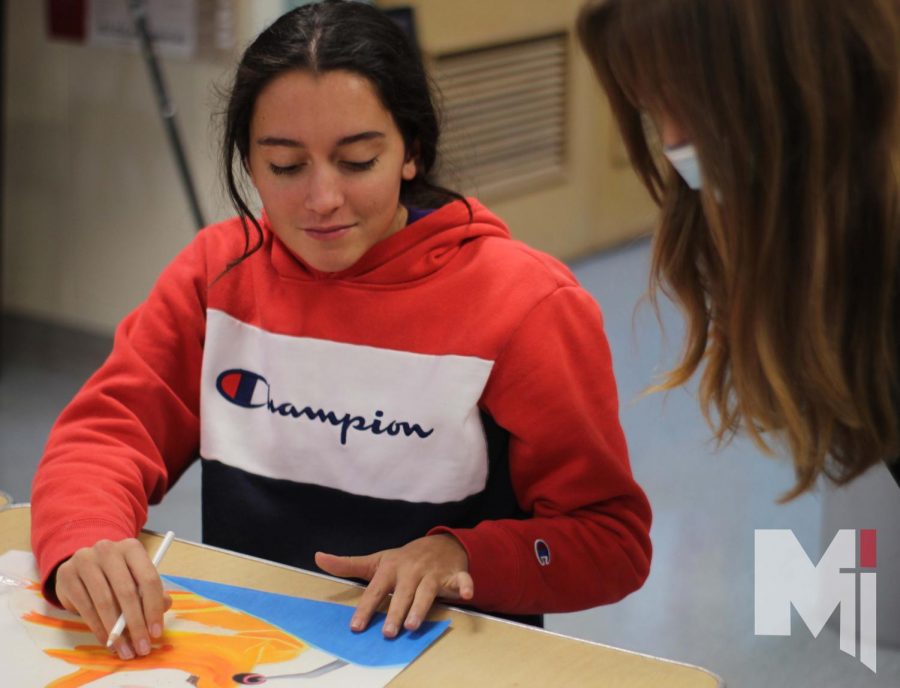College-level creativity: AP art classes foster students’ creative side
With pops of color and artistic skill, Sophia Nordling’s painting stands out among the many canvases in the AP Art storage area.
December 9, 2021
When walking into the art room, eighth hour is seemingly empty at first: the tables hold scattered students in the Portfolio Art class under the painted ceiling tiles, paintbrushes and pencils untouched. However, there is a corner of the spacious classroom that is heard before it is seen, laughter and music emanating from it. Tucked away beyond tables and cubbies is the AP Art side of the room, which hosts Miege’s creative students as they bring canvases, clay and paper to life through art.
Seniors Ffion Hughes and Caroline Brandt, both in their first year of AP Art, are among a large group at a table in the center of the peaceful chaos, heads down and voices loud. Their artwork could not be more different.
“My portfolio focuses on the theme of womanhood and femininity, and the experiences and struggles we experience daily,” said Brandt as she scrawled offensive words women hear often in the backdrop of her piece.
“I wanted to choose [a focus] I could relate to the most.”
Hughes’ portfolio, on the other hand, explores the effects cancer has on people and those around them.
“I think my artwork is better when it’s something personal to me, so I wanted to do something about my family,” Hughes said. “My grandpa has genetic cancer, and it’s been passed down in my family.”
AP art classes are the most advanced art classes that Miege offers, and college credit is available through them. There is no specific assignments given: students choose their own focus and create twenty pieces related to their topic. Before taking an AP art class, students are required to take beginner Survey of Art, followed by the year-long Portfolio Art class. The class size for 2021-22 is twelve students.
“AP Art classes allow students to work towards college credit, become independent critical thinkers, and build an Art portfolio,” said Micheal Long, art teacher and head of the Art Department.
The beauty of college-level art classes is the freedom; students choose their own focus and mediums with little restraint from teachers. On any given day students can be seen making prints from rubber carvings, splashing paint, collaging paper onto canvases and even making paper.
“I like using mediums that are unique and catch people’s eyes,” Brandt said.
However, the class stays relatively small due to the rigorous course load and artistic talent required.
“AP art courses are rigorous and fast-paced with regular deadlines,” Mr. Long said. “They require weekly studio hours outside of class and are designed for students who want to develop mastery in their art-making skills.”
The prerequisites usually limit the classes to upperclassmen, and this year there is only one junior in the class: Dania Loredo. Her focus includes nature and endangered animals in order to bring attention to environmental issues. In class, she’s typically focused on morphing clay into an elephant trunk or dabbing colors onto a jungle scene.
“In developing my focus, I really thought about what I liked and the things I was interested in,” Loredo said.
“I realized that the number one thing I liked drawing was sunsets, animals, and nature stuff. I started out with only nature, and then began focusing on environmental stuff.”
The small class size is not a weakness but rather a strength of AP Art, according to the students. Brandt, Hughes and Loredo reported that the small class size allows everyone to become friends and genuinely help each other develop their artwork.
“It [The class] is really nice because we’re all friends. We all talk, but they encourage me to work on my art as well,” Hughes said.
Through the small class size and required creativity, AP art classes encourage students to express themselves through their artwork. It’s the community, not the class, that inspires the students to create, according to Loredo.
“We really do [support each other’s artwork] a lot; we go around the room often and say nice comments or give advice about each other’s artwork,” Loredo said. “It feels like everyone gets along really well.”








